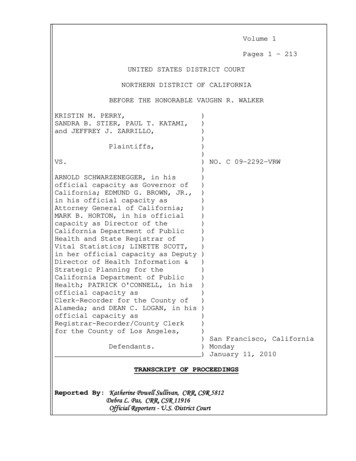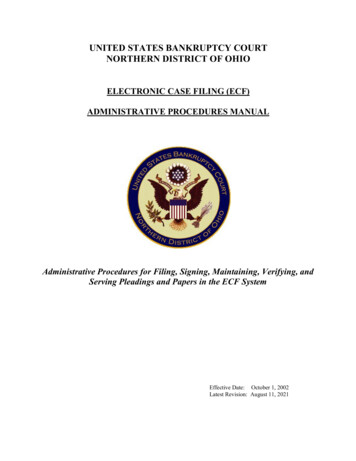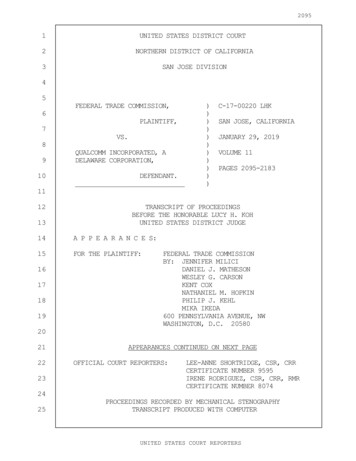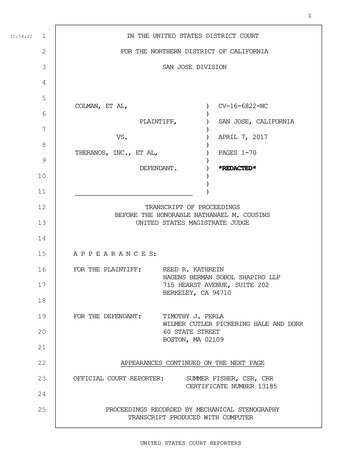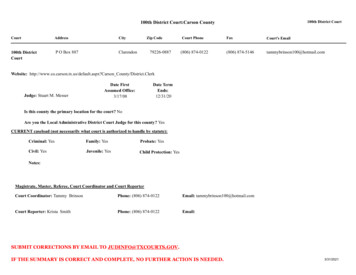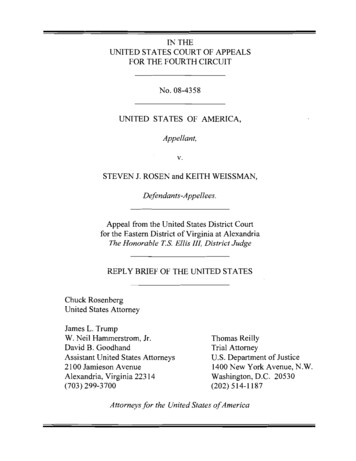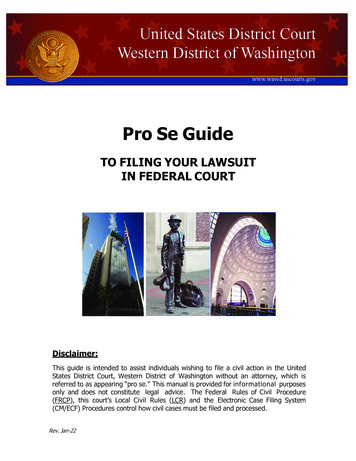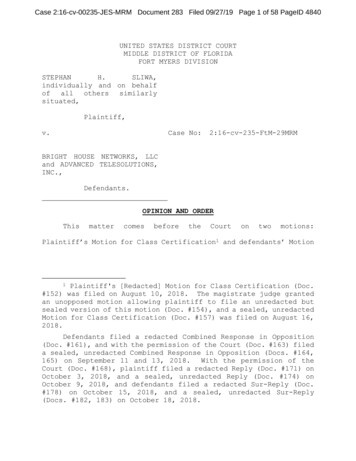
Transcription
Case 2:16-cv-00235-JES-MRM Document 283 Filed 09/27/19 Page 1 of 58 PageID 4840UNITED STATES DISTRICT COURTMIDDLE DISTRICT OF FLORIDAFORT MYERS DIVISIONSTEPHANH.SLIWA,individually and on behalfof all others similarlysituated,Plaintiff,v.Case No:2:16-cv-235-FtM-29MRMBRIGHT HOUSE NETWORKS, LLCand ADVANCED TELESOLUTIONS,INC.,Defendants.OPINION AND intiff’s Motion for Class Certification1 and defendants’ MotionPlaintiff's [Redacted] Motion for Class Certification (Doc.#152) was filed on August 10, 2018. The magistrate judge grantedan unopposed motion allowing plaintiff to file an unredacted butsealed version of this motion (Doc. #154), and a sealed, unredactedMotion for Class Certification (Doc. #157) was filed on August 16,2018.1Defendants filed a redacted Combined Response in Opposition(Doc. #161), and with the permission of the Court (Doc. #163) fileda sealed, unredacted Combined Response in Opposition (Docs. #164,165) on September 11 and 13, 2018. With the permission of theCourt (Doc. #168), plaintiff filed a redacted Reply (Doc. #171) onOctober 3, 2018, and a sealed, unredacted Reply (Doc. #174) onOctober 9, 2018, and defendants filed a redacted Sur-Reply (Doc.#178) on October 15, 2018, and a sealed, unredacted Sur-Reply(Docs. #182, 183) on October 18, 2018.
Case 2:16-cv-00235-JES-MRM Document 283 Filed 09/27/19 Page 2 of 58 PageID 4841to Exclude Plaintiff’s Expert Robert Biggerstaff2.The partieshave also filed multiple Notices of supplemental authority andresponses (Docs. ##198, 208, 210, 211, 221, 234, 235, 236, 239,242, 243, 244, 246, 255, 258, 262, 263, 266, 270, 271, 272, 273,277, 279, 280.)Defendants filed a Request for Oral Argument(Doc. #228), joined in by plaintiff (Doc. #240), and the Courtheard oral arguments on May 24, 2019.For the reasons set forth below, both motions are denied.I.On January 30, 2017, Plaintiff Stephan H. Sliwa (Plaintiff)filed a five-count Amended Class Action Complaint (Doc. #46)against defendants Bright House Networks, LLC (Bright House) andAdvanced Telesolutions, Inc. (ATS) (collectively, erProtectionAct(TCPA), 47 U.S.C. § 227 et seq. (Counts I and III), the FloridaConsumer Collection Practices Act (FCCPA), Fla. Stat. § 559.55 etseq. (Counts II and IV), and the Fair Debt Collection PracticesAct (FDCPA), 15 U.S.C. § 1692 et seq. (Count V).The AmendedComplaint alleges that Defendants attempted to collect a consumerDefendants’ Motion to Exclude Plaintiff’s Expert RobertBiggerstaff (Doc. #195) was filed on November 20, 2018, followinga redacted version (Doc. #191). A Response in Opposition (Doc.#201) was filed on December 12, 2018, followed by a sealed version(Doc. #205) filed on December 17, 2018. Defendants’ redacted Reply(Doc. #216) and sealed Reply (Doc. #222) followed.2- 2 -
Case 2:16-cv-00235-JES-MRM Document 283 Filed 09/27/19 Page 3 of 58 PageID 4842debt of unspecified nature and origin by calling Plaintiff’scellphone without his consent and/or after any consent had beenrevoked, using an automatic telephone dialing system and/or prerecorded voice technology.While the Amended Complaint doesnot say so, the record establishes that Plaintiff received callsintended for a Bright House customer at a telephone number givento Bright House by that customer which had subsequently been reassigned to Plaintiff’s cellphone.The Court takes the following background facts relevant toclass certification from the Amended Complaint and the evidencesubmitted by the parties3:From2011through2015 4 ,BrightHouseprovidedcable,internet, and phone services to customers in several states underthe Bright House brand pursuant to its Residential SubscriberAgreements (RSAs).(Docs. #164, p. 85; #165-1, p. 2.)Under the“[S]ometimes it may be necessary for the court to probebehind the pleadings before coming to rest on the ongenerallyinvolvesconsiderations that are enmeshed in the factual and legal issuescomprising the plaintiff's cause of action.”Wal-Mart Stores,Inc. v. Dukes, 564 U.S. 338, 350-51 (2011)(citations and quotationsomitted).3In mid-2016 Bright House, Time Warner Cable and CharterCommunications combined operations under the “Spectrum” brand.(Doc. #164, p. 8, n.1.)4The page numbering of the documents filed does not alwayscorrespond with the page number placed on the top of the documentby the Clerk’s Office computer at time of filing. If there is adifference, the page number used by the Court will be the numberplaced on the document by the Clerk’s Office computer at the time5- 3 -
Case 2:16-cv-00235-JES-MRM Document 283 Filed 09/27/19 Page 4 of 58 PageID 4843RSA, Bright House’s customers agreed that Bright House and itsvendors could call “the phone numbers . . . suppl[ied] to it forany purpose [via] any method, including an automatic dialing .8.)Additionally, Bright House was “entitle[d to] assume that anycommunications made through [a subscriber’s] Services or from thelocation at which [the subscriber] receive the Services are have(Id., pp. 8-9.)beenauthorisedby[theCustomers provided telephonenumbers to Bright House at various times and in various ways, andshould have, but did not always, update any change in their phonenumbers.(Id.)Also, the RSA provided for the arbitration ofdisputes on an individual (non-class) basis, subject to an optout right.(Id.)Bright House asserts that Customer H signed up for itsservices and provided it with a telephone number ending in “2025”(the 2025 Number) as a home telephone number at which Customer Hcould be contacted.(Id., pp. 11-12.)In 2014 and 2015, CustomerH confirmed the 2025 Number as the accurate contact telephonenumber.(Id.)Contrary to these assurances, in February 2013,Plaintiff had been assigned the 2025 Number for his cellphone.(Id.)of filing.- 4 -
Case 2:16-cv-00235-JES-MRM Document 283 Filed 09/27/19 Page 5 of 58 PageID 4844The Amended Complaint alleges that on February 1, tlythereafter, Plaintiff demanded that both Bright House and ATS dComplaint states that “Plaintiff expressly revoked any expressconsent Bright House may have mistakenly believed it had forplacement of telephone calls . . . .”(Id., ¶ 30.)Despiterevoking consent to receive such calls, “Defendants continued[their] barrage of phone calls to Plaintiff’s [] cellular telephonenumber in an attempt to collect a debt.”(Id., ¶ 36.)Either “atleast one,” or “numerous,” or “each” call was made by an automatictelephone dialing system (ATDS).(Id., ¶¶ 37-42.)Plaintiffasserts in the Amended Complaint that each call used a “prerecordedvoice” (PRV).(Id., ¶ 43.)Plaintiff states that Defendantscalled him at least fourteen times after being told they had thewrong number.(Doc. #157, p. 5.)Plaintiff seeks to certify two nationwide classes, assertinghe has satisfied all the requirements for such class certification.Defendants oppose the request for class certification, arguingthat: (1) The proposed class definitions are broader than those inthe Amended Complaint, are being proposed for the first time afterthe close of discovery, and are hopelessly vague; (2) there is nofeasible administrative way to identify even a fraction of the- 5 -
Case 2:16-cv-00235-JES-MRM Document 283 Filed 09/27/19 Page 6 of 58 PageID individualized inquires which will predominate over any commonquestions at trial, including the all-important issue of consentor lack of consent; (4) Plaintiff has failed to satisfy any of theremaining requirements of Rule 23 of the Federal Rules of CivilProcedure for class certification; and (5) Plaintiff and hiscounsel are inadequate representatives of the classes in partbecause of a conflict of interest created by their engagementagreement, which prohibits Plaintiff from settling or dismissingthe case against counsel’s advice even if in his best interest orthe best interest of the classes.At oral argument, counsel forDefendants identified fourteen (14) or fifteen (15) grounds ficienttodenyclass(Doc. #260.)II.The Court will first briefly summarize the pertinent legalprinciples relating to the TCPA and to class certification.A.The TCPACongress passed the Telephone Consumer Protection Act tobalance “[i]ndividuals' privacy rights, public safety interests,and commercial freedoms of speech and trade.” Tel. Consumer Prot.Act of 1991, Pub. L. No. 102-243, § 2(9) (1991).The TCPAprohibits “any person . . . [from making] any call (other than acall made for emergency purposes or made with the prior express- 6 -
Case 2:16-cv-00235-JES-MRM Document 283 Filed 09/27/19 Page 7 of 58 PageID 4846consent of the called party) using any automatic telephone dialingsystem or an artificial or prerecorded voice . . . to any telephonenumber assigned to a . . . cellular telephone service.”47 U.S.C.§ 227(b)(1)(A)(iii); see also Breslow v. Wells Fargo Bank, N.A.,755 F.3d 1265, 1266 (11th Cir. 2014) (The TCPA “makes it unlawfulto make any call using an automatic telephone dialing system (an‘autodial system’) to a cellular telephone without the priorexpress consent of the ‘called party.’”).The TCPA also created a private right of action that allowsa person to seek an injunction or monetary damages based on aviolation of § 227(b) or a regulation promulgated thereunder.U.S.C. § 227(b)(3).For each violation, a plaintiff can recoverthe greater of their actual monetary loss or 500.227(b)(3)(B).committeda4747 U.S.C. §Up to treble damages are available if the 27(b)(3)(C); see also Mais v. Gulf Coast Collection Bureau, Inc.,768 F.3d 1110, 1117 (11th Cir. 2014).“One of the key concepts in § 227(b)(1)(A)(iii) is consent.”Schweitzer v. Comenity Bank, 866 F.3d 1273, 1274 (11th Cir. 2017).Consent by the called party is an exception to the general rulethat such calls violate the TCPA, and must be established by thecaller who asserts consent.746F.3d1242,1253(11thOsorio v. State Farm Bank, )'s consent exception, State Farm must demonstrate- 7 -
Case 2:16-cv-00235-JES-MRM Document 283 Filed 09/27/19 Page 8 of 58 PageID 4847that it had the consent of Osorio, as defined by the common law,to call No. 8626.”);see also Latner v. Mount Sinai Health Sys.,Inc, 879 F.3d 52, 54 (2d Cir. 2018)(“Prior express consent is anaffirmative defense to liability under the TCPA.”); Daubert v. NRAGroup, LLC, 861 F.3d 382, 390 (3d Cir. 2017)(“As the party claimingDaubert's ‘prior express consent’ NRA would've been required toprove it at trial.”); Blow v. Bijora, Inc., 855 F.3d 793, 803 (7thCir. 2017)(“Express consent is an affirmative defense on which thedefendant bears the burden of proof.”); Van Patten v. VerticalFitness Group, 847 F.3d 1037, 1044 (9th Cir. 2017)(“Express consentis not an element of a plaintiff’s prima facie case but is anaffirmative defense for which the defendant bears the burden ofproof.”).Such “prior express consent” must be given by the “calledparty.”47 U.S.C. § 227(b)(1)(A)(iii).The “called party” meansthe subscriber to the cellphone service, not the intended recipientof the call.1267.Osorio, 746 F.3d at 1251-52; Breslow., 755 F.3d at“Prior express consent” is not defined in the TCPA statute,but has been discussed by the Federal Communications Commission(FCC) in its regulations. See e.g. In re Rules & RegulationsImplementing the Tel. Consumer Prot. Act of 1991, 7 F.C.C. Rcd.8752, 8769 (1992); In re Rules and Regulations Implementing theTel. Consumer Prot. Act of 1991, 23 F.C.C. Rcd. 559, 564 (2008).In 2014, the FCC clarified that “the scope of [an individual's- 8 -
Case 2:16-cv-00235-JES-MRM Document 283 Filed 09/27/19 Page 9 of 58 PageID 4848prior express] consent must be determined upon the facts of sS.A.R.LPetition for Expedited Declaratory Ruling Rules & RegulationsImplementing the Tel. Consumer Prot. Act of 1991, 29 F.C.C. Rcd.3442, 3446 (2014).No specific method is required under the TCPA for acaller to obtain prior consent to place automated callsor to subsequently revoke that consent. In re Rules ection Act of 1991 (2015 FCC Ruling), 30 FCC Rcd.7961, 7990. Accordingly, we recently concluded that“Congress sought to incorporate ‘the common law conceptof consent’” into the TCPA.”Lawrence v. Bayview Loan Servicing, LLC, 666 F. App’x 875, 879(11th Cir. 2016)(citing Osorio, 746 F.3d at 1256).In the EleventhCircuit, consent may be orally revoked, Osorio, 746 F.3d at 1255,and may be partially revoked.Schweitzer, 866 F.3d at 1274.“Therequirement of ‘willful[ ] or knowing[ ]’ conduct requires theviolator to know he was performing the conduct that violates thestatute.”Lary v. Trinity Physician Fin. & Ins. Services, 780F.3d 1101, 1107 (11th Cir. 2015).B.Class Certification ntgoverning class certification as follows:Before a district court may grant a motion for classcertification, a plaintiff seeking to represent aproposed class must establish that the proposed class eBremaecker v. Short, 433 F.2d 733, 734 (5th Cir.1970)1; cf. John v. Nat'l Sec. Fire & Cas. Co., 501 F.3d- 9 -law
Case 2:16-cv-00235-JES-MRM Document 283 Filed 09/27/19 Page 10 of 58 PageID 4849443, 445 (5th Cir. 2007) (“The existence of anascertainable class of persons to be represented by theproposed class representative is an implied prerequisiteof Federal Rule of Civil Procedure 23.”).If the plaintiff's proposed class is adequately definedand clearly ascertainable, the plaintiff must thenestablish the four requirements listed in Federal Ruleof Civil Procedure 23(a). Those requirements are:(1) the class is so numerous that joinder of all membersis impracticable;(2) there are questions of law or fact common to theclass;(3) the claims or defenses of the representative partiesare typical of the claims or defenses of the class; and(4) the representative parties will fairlyadequately protect the interests of the class.andFed. R. Civ. P. 23(a).Those four requirements arecommonly referred to as “numerosity, commonality,typicality, and adequacy of representation.” See, e.g.,Valley Drug Co. v. Geneva Pharm., Inc., 350 F.3d 1181,1188 (11th Cir. 2003).In addition to establishing the Rule 23(a) requirements,a plaintiff must also establish that the proposed classsatisfies at least one of the three requirements listedin Rule 23(b). Fed. R. Civ. P. 23(b); Pickett v. IowaBeef Processors, 209 F.3d 1276, 1279 (11th Cir. 2000).In this case, the plaintiffs are pursuing certificationunder the third alternative requirement, Rule 23(b)(3).Rule 23(b)(3) permits class certification if “the courtfinds that the questions of law or fact common to classmembers predominate over any questions affecting onlyindividual members, and that a class action is superiorto other available methods for fairly and efficientlyadjudicating the controversy.” Fed. R. Civ. P. 23(b)(3)(emphasis added); see Fitzpatrick v. Gen. Mills, Inc.,635 F.3d 1279, 1282 (11th Cir. 2011).- 10 -
Case 2:16-cv-00235-JES-MRM Document 283 Filed 09/27/19 Page 11 of 58 PageID 4850Little v. T-Mobile USA, Inc., 691 F.3d 1302, 1304 (11th Cir. 2012);see also Carriuolo v. Gen. Motors Co., 823 F.3d 977, 984 (11thCir. 2016).Additionally,[t]he party seeking class certification has the burdenof proof. And the entire point of a burden of proof isthat, if doubts remain about whether the standard issatisfied, the party with the burden of proof loses. Allelse being equal, the presumption is against classcertification because class actions are an exception toour constitutional tradition of individual litigation.A district court that has doubts about whether therequirements of Rule 23 have been met should refusecertification until they have been met.Brown v. Electrolux Home Products, Inc., 817 F.3d 1225, 1233–34(11th Cir. 2016)(internal punctuation and citations omitted).Thus, a plaintiff seeking class certificationmust affirmatively demonstrate his compliance with Rule23 by proving that the requirements are in factsatisfied. And the district court must conduct arigorous analysis to determine whether the movantcarried his burden, which will frequently entail overlapwith the merits of the plaintiff's underlying claim. Ofcourse, the district court can consider the merits onlyto the extent they are relevant to determining whetherthe Rule 23 prerequisites for class certification aresatisfied. But if a question of fact or law is relevantto that determination, then the district court has aduty to actually decide it and not accept it as true orconstrue it in anyone's favor.Id. (internal punctuation and citations omitted).- 11 -
Case 2:16-cv-00235-JES-MRM Document 283 Filed 09/27/19 Page 12 of 58 PageID 4851III.The context of this case is summarized as follows:While there is no consensus about the exact numbers ofreassignments, there is no dispute that millions ofwireless numbers are reassigned each year. In the eventof a reassignment, the caller might initiate a phonecall (or send a text message) based on a mistaken beliefthat the owner of the receiving number has given consent,when in fact the number has been reassigned to someoneelse from whom consent has not been obtained.Does a call or message in that situation violate thestatutory bar against making autodialer calls withoutprior consent?ACA Int'l v. Fed. Communications Comm'n, 885 F.3d 687, 705 (D.C.Cir. ingeachrequirement for class certification, and Defendants’ objections,in turn.A.Adequately Defined ClassesPlaintiff seeks to certify the following two classes inconnection with the two TCPA counts:6ATDS Class(1) All persons in the United States (2) who are not acustomer of either defendant (3) to whose cellulartelephone number [4] Defendants placed at least one nonemergency telephone call [5] using substantially thesame dialing system(s) they used to telephone Plaintiff[6] within the 4 year period preceding the filing of theAt oral argument, Plaintiff’s counsel stated that if theTCPA classes are certified, the remaining counts under the FCCPAand the FDCPA would continue in the case as individual claims byplaintiff Sliwa.6- 12 -
Case 2:16-cv-00235-JES-MRM Document 283 Filed 09/27/19 Page 13 of 58 PageID 4852complaint [7] after Defendants had already documentedthe number as a wrong number in their recordsPrerecorded Voice Class(1) All persons in the United States (2) who are not acustomer of either defendant (3) to whose cellulartelephone number [4] Defendants placed at least one nonemergency telephone call [5] using a prerecorded voice[6] within the 4 year period preceding the filing of thecomplaint [7] after Defendants had already documentedthe number as a wrong number in their records.(Doc. #157, pp. 8-9.)7Only element (5) is different for the twoproposed classes.For a class to be certified, the Eleventh Circuit requiresthat the proposed class be “adequately defined.”Little, 691 F.3dat 1303; Karhu v. Vital Pharm., Inc., 621 F. App'x 945, 946 (11thCir. 2015)(citation and quotation omitted).A proposed class isadequately defined when the class definition contains objectivecriteria which allow for the identification of class members.Karhu, 621 F. App'x at 946; City Select Auto Sales Inc. v. BMWBank of N. Am. Inc., 867 F.3d 434, 441 (3d Cir. 2017).Plaintiffasserts that each class is adequately defined because each elementis defined by objective criteria.(Doc. #157, p. 12.)Defendantssee the matter quite differently, asserting there are a host ofproblems with these proposed class definitions.15-21.)(Doc. #164, pp.The Court will address Defendants’ objections below.Each of the proposed class definitions used “(3)” twice, sothe Court has renumbered the remaining components of eachdefinition.7- 13 -
Case 2:16-cv-00235-JES-MRM Document 283 Filed 09/27/19 Page 14 of 58 PageID 4853(1)Changed Scope of Proposed ClassesDefendants argue that the proposed class definitions arebroader than those set forth in the Amended Complaint, thereforerendering class certification inappropriate.Defendants assertthat Plaintiff’s initial classes only included persons who had notconsented to being called, while the new classes include allpersons who may be tied to a “wrong number” notation in any ofDefendants’ records, regardless of whether Defendants had consent.(Doc. #164, pp. 15-16.)In their written materials submitted atoral argument (Doc. #260), Defendants also complained that theproposed classes violate the due process rights of others becausethe current proposed classes exclude persons who had been in theoriginal proposed classes.Plaintiff argues that even after discovery “there is noevidence of consent for any of the numbers in the class.”#157, p. 11.)(Doc.Additionally, Plaintiff replies that the proposedclasses are not broader than those set forth in the AmendedComplaint, but are actually narrower.Plaintiff asserts that hesimplified the definitions to include only non-customers who, bydefinition, did not consent.(Doc. #174, pp. 1-2.)In order to give rise to a claim under the TCPA, a call musthave been made “using any automatic telephone dialing system or anartificial or prerecorded voice . . . to any telephone numberassigned to a . . . cellular telephone service[.]” 47 U.S.C. §- 14 -
Case 2:16-cv-00235-JES-MRM Document 283 Filed 09/27/19 Page 15 of 58 PageID 4854227(b)(1)(A)(iii).As discussed earlier, the lack of “priorexpress consent of the called party” is an affirmative defense toa TCPA claim, and therefore need not be negated in the complaint.8La Grasta v. First Union Sec., Inc., 358 F.3d 840, 845 (11th mplaintincluded all persons in the United States to whose cellulartelephone number Defendants placed a non-emergency telephone call“using substantially the same system(s) that were used to telephonePlaintiff” where Bright House or ATS “did not have express consentto call said cellular telephone number.”(Doc. #46, ¶¶ 88-89.)A proposed sub-class consisted of persons receiving such calls“after that person had instructed Bright House [or ATS] to ceasecalls to that number.”(Doc. #46, ¶¶ 88, 89.)The Courtconcludes that while the language defining the proposed classes inthe Amended Complaint is different from the language currentlyproposed, the differences are not so significant as to requiredenial of class certification.(2)New Prerecorded Voice ClassDefendants also assert that Plaintiff never before proposeda class tied to the use of a prerecorded voice, since the classesset forth in the Amended Complaint only related to the automaticAs discussed later, consent or the lack of it is a materialissue for some of the Rule 23 requirements.8- 15 -
Case 2:16-cv-00235-JES-MRM Document 283 Filed 09/27/19 Page 16 of 58 PageID 4855dialing system.(Doc. #164, p. 15.)According to Defendants,this new class must be disallowed.Plaintiff responds thatdiscovery has established that all the calls at issue were made byATS using a single calling system, the Aspect Unified IP dialer.This dialing system placed some prerecorded calls and some callsthat were not prerecorded.Therefore, Plaintiff argues, allmembers of the Prerecorded Voice Class will be members of the ATDSclass. (Doc. #174, pp. 1-2.)The “systems” used to telephone Plaintiff are consistentlydescribed in the Amended Complaint as including prerecorded calls.(Doc. #46, ¶¶ 4, 6, 30, 43, 53, 55, 59, 60, 61, 70, 71, 72.)Thus,the proposed prerecorded voice class is not so different from theoriginal proposed classes that certification must be denied onthat basis alone.(3)Changes to Class Definitions After Close of DiscoveryDefendants assert that the timing of the amended proposedclasses - after the close of discovery – renders certification ofsuch classes a violation of due oneofthecontourstheof(Doc. #164, p. 16.)proposedthechangesclassesorwillundulyprejudice Defendants and therefore would not violate due process.Defendants actually argue that this type of tactic is a“type of switcheroo.”(Doc. #164, p. 16.)The Court looselytranslates that to be a due process issue.9- 16 -
Case 2:16-cv-00235-JES-MRM Document 283 Filed 09/27/19 Page 17 of 58 PageID 4856(4)Vague TerminologyDefendants argue that the proposed classes are so vaguelyworded that it is difficult to tell who Plaintiff intends toinclude in the classes.(Doc. #164, pp. 4-5, 17-18.)Plaintiffdisagrees, as does the Court.Defendants assert that element (2) is vague because theycannot tell who qualifies as a “customer” in the phrase “not acustomer” of either defendant.The declarations submitted onDefendants’ behalf by David W. Zitko, Scott Van Nest, and Ryan D.Watstein (Docs. ##165-1, 165-3, 165-5) demonstrate no difficultyin understanding the concept of “customer.”The Court rejectsDefendants’ argument that the term “customer” is unduly vague.As to element (3), Defendants argue that the phrase “to whosecellular telephone number” Defendants called is vague because itfails to explain whether this includespersonswho werethecellular subscribers, or the customary users of the cellphone, -subscriber customary users may consent to receive calls, consentis a complete defense to TCPA liability, and it is impossible eway.(Doc. #164, p. 17.)Plaintiff replies that the class definition includes ceasubscriber has the cause of action, even if it was someone other- 17 -
Case 2:16-cv-00235-JES-MRM Document 283 Filed 09/27/19 Page 18 of 58 PageID 4857than the subscriber who answered a call.(Doc. #174, p. 3.)Thisposition further agitates Defendants, who complain that it is yetanother amendment to the proposed classes made long after the closeof discovery.(Doc. #182, p. 3.)The Court agrees that the “whose” in the phrase “to scriber of that cellular telephone number.onlytotheThis comports withthe law in the Eleventh Circuit that a “called party” for purposesof § 227(b)(1)(A)(iii) means the subscriber to the cellphoneservice, not the intended recipient.52; Breslow, 755 F.3d at 1267.Osorio, 746 F.3d at 1251-This construction causes noprejudice to Defendants since it has been the law in the EleventhCircuit since 2014, and is a narrower definition than at least onecircuit would allow.See Leyse v. Bank of Am. Nat. Ass'n, 804F.3d 316, 325 n.13 (3d Cir. 2015);see also Soppet v. EnhancedRecovery Co., LLC, 679 F.3d 637, 643 (7th Cir. 2012)(“We concludethat ‘called party’ in § 227(b)(1) means the person subscribing tothe called number at the time the call is made.”).Defendants argue that element (7) ties class membership torecords which “document the [cellular phone] number as a wrongnumber,” but does not specify what records those may be, whichdefendant holds the records, and what type of entry would documenta wrong number.(Doc. #164, pp. 14-15.)- 18 -Defendants assert this
Case 2:16-cv-00235-JES-MRM Document 283 Filed 09/27/19 Page 19 of 58 PageID 4858makes it unclear as to which cell phone numbers fall within theclass definitions.(Id., p. 17.)The Court finds that the class definitions do not need todefine which records are being utilized.the existence ofsuch documentationThe operative fact isin the records, not theidentity of the record in which the documentation is contained.Finally, Defendants’ due process and Rule 23 notice argumentscontain no small amount of irony.Defendants argue that thereshould be no members of any class, yet complain that Plaintiff’sdefinitions would violate due process and/or Rule 23 by excludingsome persons who would have been potential members of his originalproposed classes.founded.In any event, Defendants’ objection is not wellWhile there is a statute of limitations benefit10, anasserted member of a proposed class does not have a vested rightin a certified class, and the person suffers no due processviolation if not included in the ultimate class which is certified.In American Pipe & Construction Co. v. Utah, 414 U.S. 538,554 (1974), the Supreme Court held that “the commencement of aclass action suspends the applicable statute of limitations as toall asserted members of the class who would have been parties hadthe suit been permitted to continue as a class action.” In Crown,Cork & Seal Co., Inc. v. Parker, 462 U.S. 345, 353–54 (1983), theSupreme Court extended American Pipe tolling to would-be classmembers who filed separate actions after the denial of classcertification.10- 19 -
Case 2:16-cv-00235-JES-MRM Document 283 Filed 09/27/19 Page 20 of 58 PageID 4859The Court will restate the proposed class definitions asfollows:ATDS Class(1) All persons in the United States (2) who are not acustomer of either defendant (3) who subscribed to acellular telephone number (4) to which Defendants placedat least one non-emergency telephone call (5) using anAspect Unified IP dialer system11 (6) within the 4 yearperiod preceding January 30, 201712 (7) after Defendantshad already documented the number as a wrong number intheir records.Prerecorded Voice Class(1) All persons in the United States (2) who are not acustomer of either defendant (3) who subscribed to acellular telephone number (4) to which Defendants placedat least one non-emergency telephone call (5) using aprerecorded voice (6) within the 4 year period precedingJanuary 30, 2017 (7) after Defendants had alreadydocumented the number
RSA, Bright House's customers agreed that Bright House and its vendors could call "the phone numbers . . . suppl[ied] to it for any purpose [via] any method, including an automatic dialing system or an artificial or recorded voice." (Doc. #164, p. 8.) Additionally, Bright House was "entitle[d to] assume that any
